Barb Winters's Blog, page 7
April 3, 2023
Mom, I See You
As a young mom, I wrestled with thoughts that I wasn’t enough. I didn’t purchase the right clothes or decipher my children’s needs correctly. I wasn’t contributing to the household income or spending enough time raising my children. The meals were inadequate and the house wasn’t clean. If I sat with the children to play a game, supper was late. If I spent too much time reading to them, they may not learn necessary life skills. The never-ending tug and pull in my mind. Can you relate? Mom, I see you.
As my children matured and I began homeschooling, I struggled with character-building versus teaching academics. And always the thought that maybe I should get a real job, a job that put money in the bank.
Then one day these children of mine were making their own decisions, becoming human beings with their own likes and dislikes, right before my eyes. This one only wore jeans. That one never wore jeans. This one wanted a drum set. That one wanted a guitar. This one excelled in math. That one hated math. It baffled me that I could parent four children in essentially the same manner but yield four completely different individuals.
I did my best to guide and direct. To lead and steer. All while allowing each to grow and become their own person. All while still growing myself and continuing to become my own person. And trying not to feel inadequate at the end of each day.
An internal battle plagues most moms, often resulting in feeling like a failure. You may be downtrodden and feel lost and alone, but there is light at the end of the tunnel. #hopefulmom #momguilt Mom, I See You
Click To Tweet
I think this internal battle plagues most moms. In every homeschool group, mom church group, and mom coffee chat, I’ve heard moms lament their struggle. When I’ve worked, I’ve listened to moms wonder if they should be home with their kids. How do we rise to the responsibility of raising children without failing? How do we hold on to ourselves and serve our children (and spouses) well? If that’s you, mom, I see you.
Of course, in our home, we had our fair share of triumphs and failures; laughter and tears; celebrations and pity-parties; wins and losses. And we persevered. Each day, I got out of bed. Each day, I learned and grew. Each day, my children learned and grew.
Then there was that one day. My son had been watching pornography. And the previous decade and a half of doing my best, learning and growing, teaching and molding, crashed to the ground. Failure. I wore the label over my heart and head, forgetting the hard climb with victories along the way. If you’ve had a day like this one, mom, I see you.
You are not alone. And that one day does not define you. That one misstep, failure, dilemma, issue, plague, does not mean you are a failure. As traumatic as the problem may be, as deep as the hole may go, as diseased as the wound may seem, hope exists. Others have walked this road and been okay.
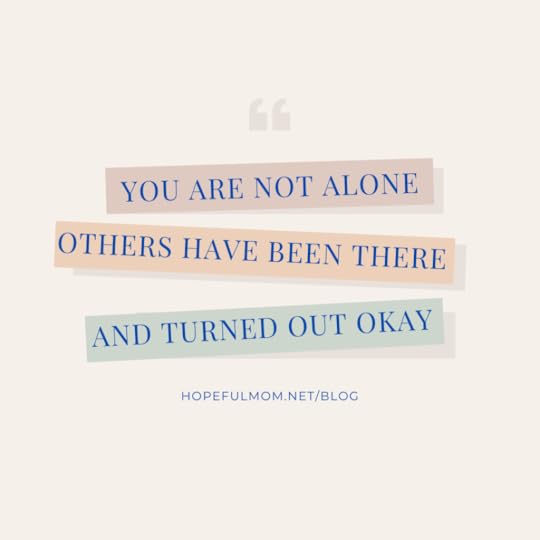
Mom, I see you. You may be downtrodden and feel lost and alone, but there is light at the end of the tunnel. Take a deep breath. Exercise. Listen to music that lifts your spirits. Eat well and get some sleep. Go for a walk, run, or bike ride. Play tennis or swim. Spend time with people who make you laugh. Renew, refresh, rejuvenate.
Then, go back in. Walk with your child through the process of healing knowing you have an army of Mamas (and Dads, too) who are on your side and have your back.
The post Mom, I See You appeared first on HOPEFUL MOM.
March 20, 2023
Training Wheel Consequences and Alternate Behavior Changes
Nick and I talked a few months ago about his app, Relay. He and his team designed this fairly-new app to help those trapped in pornography’s grip by teaming people up into support groups. I recommend you check it out. Nick’s enthusiasm and passion are contagious, so I’m thrilled that he agreed to write this post about training wheel consequences for you.
One reason raising children is so hard is that they often don’t internalize the link between cause and consequence. They don’t like their stomach to hurt, yet they still eat half their Halloween candy in one sitting. They don’t like to get sunburned, but they won’t let you lather sunscreen on before they run out to play. Because children have a hard time understanding the true impact of their actions, parents often create what I call “training wheel consequences”; let’s examine these consequences and consider how we can reframe them, particularly in the context of pornography habits, to help children make lasting behavioral change.
Example: Video GamesWhen a child breaks a rule — say, plays more than an hour of video games in one day — their parents may discipline them by taking away their video game console.
What is the real-world impact of playing more than an hour of video games in one day? On that day, essentially nothing. Perhaps the child will be more ornery for the rest of the evening or forget a homework assignment — relatively small consequences. However, the future impact of playing more than an hour of video games is potentially large and negative; the child may learn it is okay to play video games to excess and form a habit that crowds out formative relationships and more productive interests.
Children don’t see this possibility, but parents do, and as a result parents tend to institute negative consequences that are much more immediate and tangible (and far smaller than the potential real-world impact): training wheel consequences. Removal of the video game console is a prime example.
Let’s now consider the impact of this training wheel consequence. The child learns they can’t play video games for more than an hour or else the source of their entertainment will be removed. This may well help them avoid the long-term consequences of playing video games for more than an hour. However, children do recognize that training wheel consequences are artificially imposed; this may lead the child to resent their parents’ training wheel consequence, to leave and secretly play video games at friends’ houses where they can avoid the training wheel consequence, and potentially to play video games to excess as soon as they move out for college, once they’re “free” of the training wheel consequence.
How can parents help their children avoid destructive behaviors? Move from training wheel consequences to more productive methods with these four suggestions from Nick Van Slooten of Relay App. #hopefulmom #difficultconversations…
Click To Tweet
If training wheel consequences can have an impact just as negative as not imposing any consequence, how can parents help their children avoid destructive behaviors?
Psychology suggests one answer: help children recognize the future consequences of destructive behavior and choose to avoid them (this applies to pornography habits and others). This is far more easily said than done, but here are a few suggestions:
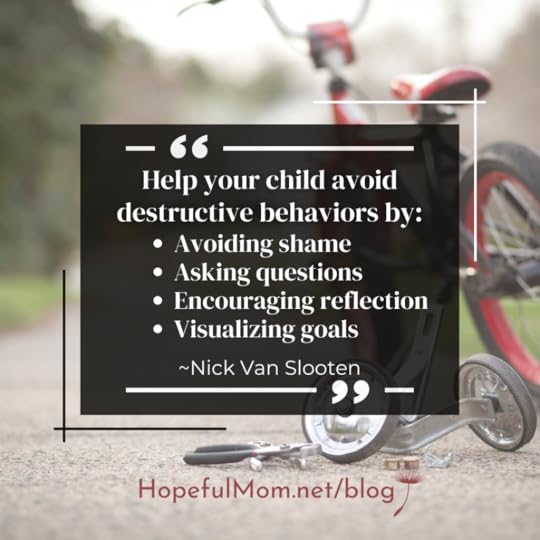 Avoid shaming in any form. This must be the cardinal rule to keep in mind before any parental intervention, because introducing shame into any interaction can engender trauma that actually perpetuates the destructive behavior.Enable your child to direct training wheel consequences. Consider which consequences you impose might be “training wheels” (e.g. taking away a phone). Talk with your child about it — perhaps apologize for imposing an artificial consequence, and explain that you wanted to help them. Ask them what they think would be an appropriate way for you as a parent-child team to respond to the destructive behavior instead of your chosen training wheel consequence.Help your child visualize a positive future with goal-setting. Encourage them to write down their top 3-5 goals for the person they want to become and help them ponder those goals regularly. Don’t tie this exercise to the behavior you want them to avoid — rather, focus entirely on the positive, and let them build their own vision for their life. Trust that your child will recognize the negative consequences of the destructive behavior and create a path to achieve their goals that does not include the behavior.Encourage reflection. As children reflect on their lives and actions, they are more able to link their behaviors with the consequences of those behaviors and find positive ways to cope with stressors. Journaling is a great way for your child to reflect in an unguided, self-directed way, though incentivizing journaling isn’t always easy. Coaching or counseling can be a more hands-on way to help your child reflect with another person in a more structured manner.
Avoid shaming in any form. This must be the cardinal rule to keep in mind before any parental intervention, because introducing shame into any interaction can engender trauma that actually perpetuates the destructive behavior.Enable your child to direct training wheel consequences. Consider which consequences you impose might be “training wheels” (e.g. taking away a phone). Talk with your child about it — perhaps apologize for imposing an artificial consequence, and explain that you wanted to help them. Ask them what they think would be an appropriate way for you as a parent-child team to respond to the destructive behavior instead of your chosen training wheel consequence.Help your child visualize a positive future with goal-setting. Encourage them to write down their top 3-5 goals for the person they want to become and help them ponder those goals regularly. Don’t tie this exercise to the behavior you want them to avoid — rather, focus entirely on the positive, and let them build their own vision for their life. Trust that your child will recognize the negative consequences of the destructive behavior and create a path to achieve their goals that does not include the behavior.Encourage reflection. As children reflect on their lives and actions, they are more able to link their behaviors with the consequences of those behaviors and find positive ways to cope with stressors. Journaling is a great way for your child to reflect in an unguided, self-directed way, though incentivizing journaling isn’t always easy. Coaching or counseling can be a more hands-on way to help your child reflect with another person in a more structured manner. These are just a handful of ways you can help your child recognize and exercise their agency to avoid the future consequences of destructive behaviors rather than imposing artificial barriers yourself. The general principles are more important than the specific methods you use to implement, but above all, remember to avoid generating shame in your interactions with your child regarding their destructive behavior, as that will not solve but exacerbate the problem.
Relay AppA quick shameless plug — my team and I have worked hard to incorporate these principles into our pornography recovery app, “Relay – Improve Together.” We match teens and adults into support groups and provide a shame-free environment with daily opportunities for reflection and structured goal-setting. Feel free to download and join as a “supporter” to explore it yourself.
ConclusionTraining wheel (artificially imposed) consequences can harm a child more than they help change behaviorInstead, find ways to help your child recognize the consequences of destructive behavior and choose to avoid themThanks for reading. Which suggestion did you find most helpful?
Before you go, subscribe to Hopeful Mom below and follow Hopeful Mom on Facebook, Instagram, and LinkedIn.
The post Training Wheel Consequences and Alternate Behavior Changes appeared first on HOPEFUL MOM.
March 6, 2023
Are Our Children Targeted Online?
When I started Hopeful Mom four years ago, my goal was to wrap my virtual arms around other parents who were hurting because their child had been exposed to pornography. I focused on the parent’s internal struggles and emotional healing. These are still priorities; however, Hopeful Mom has expanded. Education (for ourselves and our children) and communication (with each other and with our children) about pornography and other online dangers are imperative.
We should learn about all things online because they are interconnected. One feeds into another. A child exposed to porn is more susceptible to predators, peer pressure, and esteem issues that lead to worry, anxiety, and depression.
I recently saw a post on the Facebook page, “Parenting in a Tech World” run by Bark. I asked the original poster’s permission to quote her. Here is an edited-for-length excerpt:
“We almost lost a child last week and it happened in a matter of 12 hours. . . . We made the decision to put smartphones in the hands of our two oldest when they reached middle school. We set parameters, monitored them daily, talked to the kids about known dangers, and downloaded apps to help us monitor usage. We thought we were doing enough. We weren’t. One of our kids was targeted by a predator through Instagram. Our week has involved conversations with our local police and the FBI.
If you are the parent of a teen with a smartphone and social media, please talk to them. Talk to them about who they message. Tell them how easy it is for people to create fake accounts and manipulate them. Take the phone and look through it yourself, every day. . . . As I was messaging the online predator pleading with them to leave my child alone, their demands were simple, pay them $500 and they would stop. At one point, this person said to me, “When I’m finished, they will commit suicide.”
We were one of the lucky ones, because when our child thought they ran out of options, they came to us. . . .Talk to your kids. Now. Do it for them. Talk to them.”
A recent thread about sextortion on a FB page caused me to ponder this question: Are Our Children Targeted Online? #hopefulmom #onlinesafety #sextortion #difficultconversations
Click To Tweet
My heart fell when I read the above. But the disheartening messages didn’t stop there. In the comments, there were too-many-to-count replies from parents stating their children experienced something similar. They were targeted also. Here’s a sample of the responses (edited for length and to keep anonymity):
We’re going through something very similar. . . . My daughter is 11 and was targeted through Roblox. . . . An 11-year-old daughter . . . willingly got in the car of someone they didn’t know and disappeared. She was groomed for weeks on social media. They had promised her some “work” so she could help her Mom pay the rent.I heard from my son the other day that some kids were taking pics of their feet and selling them. They thought it was funny. Yikes!Ours was groomed and being sex trafficked. I discovered it hours before she was leaving . . . against my knowledge. . . . Even though we know the parent was involved, technically the minor was doing the grooming.I went thru this with my granddaughter. It started out thru Instagram. I told [them] . . . she was only 14 and [they] said . . . I love kids!! I prefer kids over adults. I don’t care if your child gets upset because you go thru their phone. It isn’t a matter of trusting them, it’s a matter of NOT trusting others!If this is one of the scams that tricks these teens into sending nudes and then they turn and demand money or they’ll post it, I now know 5, yes FIVE, of my personal friends who have now had this done to their children. They are so scared to come to their parents because of embarrassment and they think sending the money makes it go away. It doesn’t! It makes them demand more and more money.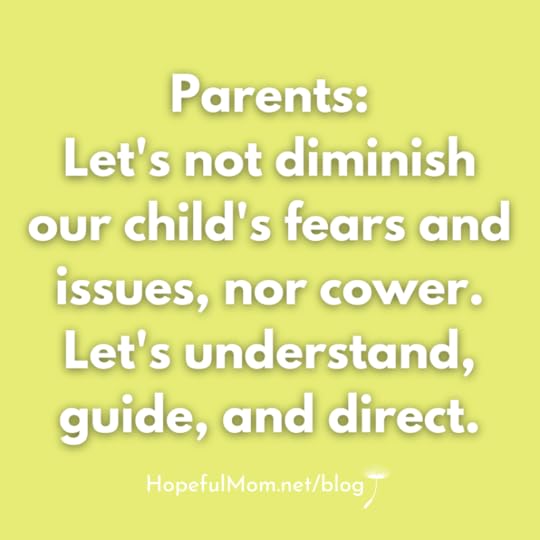 Two boys in our community killed themselves just weeks apart. They were being blackmailed too. They target good kids that feel so ashamed and feel there is no way out.This happened to us . . . through a chat on a video game that moved to Instagram. This person . . . sent prerecorded video messages as a girl, sent pics and more to make the boys involved believe they were talking to a girl their age.Same scenario for us. Our children/teens are not prepared to handle what is out there even when we think we have all the safeguards in place.We didn’t allow social media, and our oldest still found a way to make THREE accounts. She was also targeted . . .As a pediatric ER nurse, I cannot even begin to tell you how many young kids we see that met people online and . . . held against their will.Same thing happened to my college age son a few weeks ago except the demand was 2K. . . . He was so distraught.I was a victim of sextortion and people need to know they start off asking simple things like what did you eat today, did you exercise, how did you sleep? Daily fake care that goes on for weeks until you fully trust them. Please make your kids aware.Our Response
Two boys in our community killed themselves just weeks apart. They were being blackmailed too. They target good kids that feel so ashamed and feel there is no way out.This happened to us . . . through a chat on a video game that moved to Instagram. This person . . . sent prerecorded video messages as a girl, sent pics and more to make the boys involved believe they were talking to a girl their age.Same scenario for us. Our children/teens are not prepared to handle what is out there even when we think we have all the safeguards in place.We didn’t allow social media, and our oldest still found a way to make THREE accounts. She was also targeted . . .As a pediatric ER nurse, I cannot even begin to tell you how many young kids we see that met people online and . . . held against their will.Same thing happened to my college age son a few weeks ago except the demand was 2K. . . . He was so distraught.I was a victim of sextortion and people need to know they start off asking simple things like what did you eat today, did you exercise, how did you sleep? Daily fake care that goes on for weeks until you fully trust them. Please make your kids aware.Our Response Why bring this up? Why burden your heart with this heavy thread?
Because knowledge is power.
Our children face a significant amount of pressure every day both in person and online. When we understand their daily pressures, that they are targeted, we are better equipped to help them. Let’s not diminish their fears and issues. Let’s not cower either. Instead, let’s walk with them, guiding and directing. Let’s be available to soothe their emotions and offer them advice.
Remind your children today of their value and worth. Pick them up when they fall into a trap. Empower them to walk away from people who want to harm them and trust those who care for them. Teach them the difference between the two.
Parenting is a long endeavor with hills and valleys. But it’s worth it. I’m grateful you’re in it for the long-haul. I believe in you. You’ve got this!
Thanks for walking this road with me. If you haven’t had a chance to look at the website page with my book information, check it out. Please share this post through email or on your social media account. It’s so important to inform other parents of the dangers their children face every day. Subscribe below for updates and follow Hopeful Mom on Facebook, Instagram, and LinkedIn.
The post Are Our Children Targeted Online? appeared first on HOPEFUL MOM.
February 20, 2023
6 Principles of Teaching Boundaries and Consent
Consent and boundaries continue to be a hot topic. And, sadly, most people don’t understand the definition of consent much less how to ask for it. So when I heard Chris Yadon of Saprea present on this topic at the CESE Summit, I knew his message was for us. Thank you, Chris, for this timely message.
Nothing will get the hair to stand up on the back of your neck more than when you feel your child is threatened. When my oldest daughter was a sophomore in high school, I remember her coming home and relating that a boy kept hugging her despite her making it clear that she did not want him to. My initial instinct was to immediately intervene, but then I remembered that, in this case, I had the opportunity to reinforce boundaries and consent – principles I had been teaching her for many years. I asked her if she wanted me to intervene or if she would like to try one more time to set and hold a boundary. She elected to do the latter and once more communicated her boundary to this boy. He knew she was serious, and he respected the boundary knowing he needed her consent to hug her.
Parents have many opportunities to teach boundaries and consent. They happen every day as soon as parenthood begins. Think of when your toddler says no to their sibling, when your 8-year-old asks for privacy to change their clothes, and when your teen goes on their first date. Each of these situations are day-to-day opportunities to teach principles that can be essential when our teens face high-stakes circumstances such as an attempted sexual assault or dating violence. They also model for kids what a healthy relationship looks like, romantic and otherwise.
As parents, we can reduce the risk our children will be assaulted or assault others as we follow six principles.
Principles that reduce the risk of our teens being assaulted:Bodily autonomy. When we teach bodily autonomy and that our teens have an inherent right to decide who can touch them and how they can be touched, they feel empowered to say no when they are uncomfortable.Setting and holding boundaries. When we teach our children how to set and hold boundaries, we model acceptable behaviors and interactions with others. This is especially powerful when they set a boundary with us and we honor that boundary.Finding and using your voice. Helping our teens learn to use their voices to communicate when they are uncomfortable allows them the trust and words to share with you when someone else is making them uncomfortable. And they may even be able to share that voice clearly and directly to those who are pushing against their boundaries.
Teaching bodily autonomy to our children empowers them to say no when they feel uncomfortable. ~ Chris Yadon of Saprea #consent #boundaries #healthyrelationships 6 Principles of Teaching Boundaries and Consent
Click To Tweet
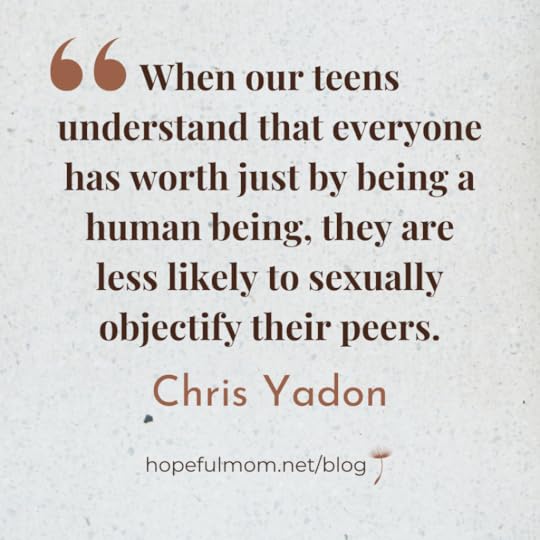
In the US, some 9.7% of high school age teens report being sexually assaulted in the last 12 months.1 This is abhorrent. As parents, we can change this statistic by teaching our children the principles of boundaries and consent.
Learn more about boundaries and consent by visiting Saprea’s free prevention resources at saprea.org.
—–
1 – Center for Disease Control, Youth Risk Behavior Surveillance System, 2019.
Thanks for joining us here at Hopeful Mom. If you’ve found this post or this website beneficial, please tell others. Share through social media or by email. In so doing, you may be offering another parent or grandparent hope.
The post 6 Principles of Teaching Boundaries and Consent appeared first on HOPEFUL MOM.
February 6, 2023
Recent Pornography Statistics and Why They Are Important
When I learned my son was watching pornography I had a difficult time reconciling how this could have happened in my home. As I’ve mentioned in other posts, we were a home-schooling family who taught right from wrong to our children. I assumed my children would make good choices as they matured.
Reading pornography statistics helped me deal with my emotions and what I perceived as inept parenting. Our situation wasn’t an anomaly; rather, it was common. When I learned how prevalent this behavior was, I managed to step outside myself and view this issue from a societal standpoint. Pornography is a public concern.
Last month, Common Sense Media released a report entitled 2022 Teens and Pornography. The 27-page report is a compilation and summary of a survey conducted with 1358 teens age 13 to 17.
I’d like to outline some of their findings here in hopes that understanding these pornography statistics helps you parent your children better. I can’t possibly hit every point or stat in the report, so I recommend reading the full report yourself.
Before listing specific stats, I think it’s important to understand the purpose of the report and Common Sense Media’s definition of pornography.
“The purpose of the report is to understand the role that online pornography plays in U.S. adolescent life and to establish a baseline for understanding U.S. teens’ pornography use. For this report, online pornography includes any videos or photos viewed on websites, social media, or anywhere else on the internet that show nudity and sexual acts intended to entertain and sexually arouse the viewer. Pornography often features explicit pictures of body parts (such as the genitals) and sexual acts (including oral sex, masturbation, anal sex, etc.).” (All quotes in this post are from the Teens and Pornography report.)
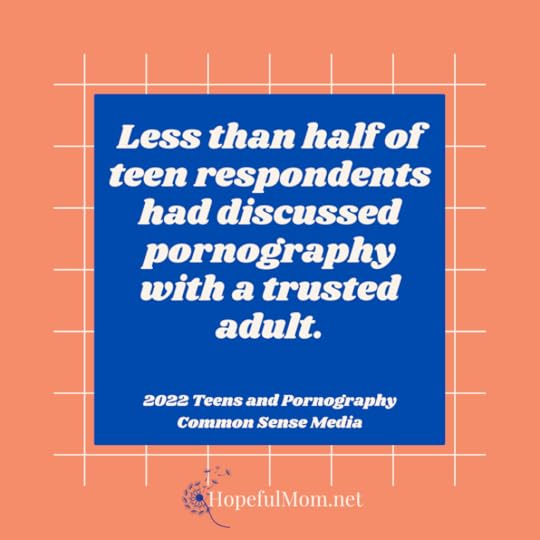 10 Key Findings
10 Key FindingsThe Common Sense Media report lists the following key findings from the survey.
“Most teens (73%) reported that they have consumed pornography.” The average age of first exposure was 12, with 15% saying they had first seen porn at age 10 or younger.“Just under half of all teens (44%) indicated that they had done so intentionally, while slightly more than half (58%) indicated they had encountered pornography accidentally.” 29% reported both intentional and accidental viewing.Of those reporting accidental exposure, 63% indicated they had been exposed in the past week, “which could indicate that unintentional pornography exposure was a common experience for respondents.”Reported rates of exposure were similar across demographics, but there was a “significant difference by gender in terms of intentional consumption.”“Rates of intentional pornography consumption were also higher among respondents who are LGBTQ+ (66%), including transgender and nonbinary respondents (66%).”“There was tension between respondents’ enjoyment of pornography and their feelings of guilt associated with consuming it.” Most felt “OK” about the amount of pornography they watched, but “half reported feeling guilty or ashamed after watching.”“Teens indicated that they were learning about sex from the pornography they consume.”“A majority of teens who indicated they have viewed pornography have been exposed to aggressive and/or violent forms of pornography.”“Exposure to racial and ethnic stereotypes in pornography was also common.”Most teens have discussed sex-related issues with trusted adults, “but less than half (43%) have discussed pornography.”Other Notable Findings“Nearly one third of all teens reported that they have been exposed to pornography during the school day.” Among all teens surveyed, 23% had seen porn in person at school and 12% while attending school remotely. Of those who had watched pornography in person at school, 41% attended a private/religious school, 20% a traditional public school, 31% a charter/magnet school, and 11% were home schooled. While there is a difference in the number of children exposed depending on their school type, we should note that all children are at risk of being exposed during the school day.
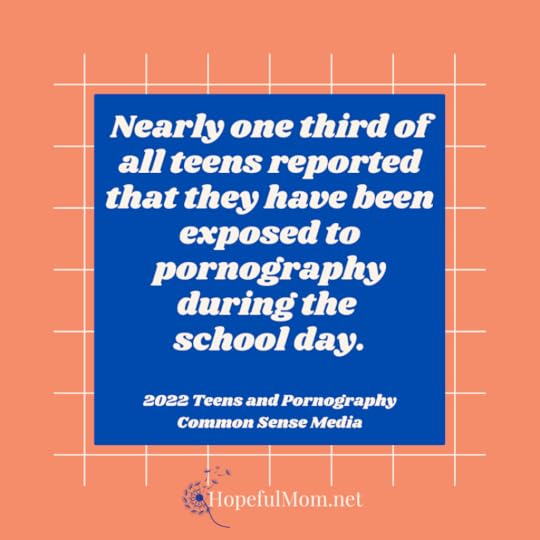
“Of the teens who reported in this survey that they have deliberately viewed pornography, 59% indicated that they intentionally consumed pornography every week (not just in the previous seven days).” Of these, 38% viewed it through social media.
Trusted AdultsBecause of my interactions with parents, caregivers, and leaders, I was most interested in the portion of the report about trusted adults. In the list of places where teens had learned about sex, the highest-ranking category was a parent, caregiver, or trusted adult (47%), followed by friends (41%), sex education in school (32%), and then online pornography (27%). When teens were asked about topics discussed with a parent, guardian, or trusted adult, relationships came out on top (82%). Porn was the topic least discussed (43%) with sex, condoms, and birth control ranking between these two topics.
"Many teens wish to have conversations with a trusted adult" about pornography, according to the new 2022 Teens and Pornography report by Common Sense Media #fightthenewdrug Recent Pornography Statistics: Why They Are Important
Click To Tweet
Most teens in the survey reported positive outcomes resulting from their conversations with a trusted adult about pornography.
Many teens wish to have conversations with a trusted adult but don’t know how to initiate the conversation or said they didn’t know who to talk to.
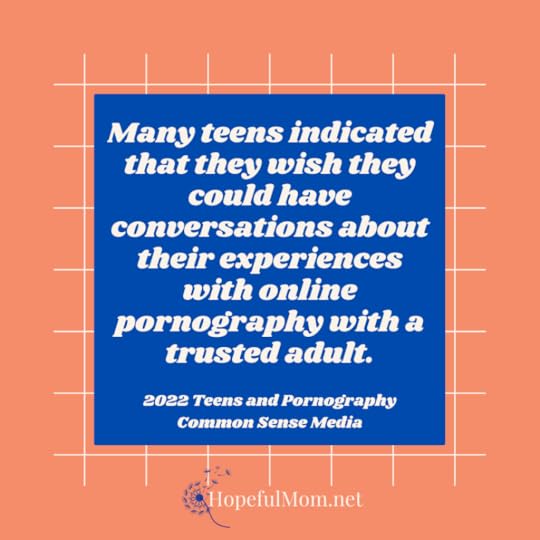 Now What?
Now What?The good news is that we can and do influence our teens, and they want to hear from us. While these pornography statistics could be depressing, we can be encouraged by the fact that we now have more information and are better equipped to talk with our children.
We cannot ignore these pornography statistics. The time to act is now. If you haven’t broached this topic with your children, do so. If you’ve had conversations but they’ve been awkward or seemingly unproductive, that’s okay. Try again. If you need help getting started, read through past blog posts on this site or use books from the resources page. You can do it!
Be sure to subscribe using the form below. And follow Hopeful Mom on Facebook, Instagram, and LinkedIn. Coming Soon . . . book cover reveal! *insert squeal here*
The post Recent Pornography Statistics and Why They Are Important appeared first on HOPEFUL MOM.
January 23, 2023
Tips to Keep Your Teens Safe From Online Sexual Exploitation and Harassment
Jenna Greenspoon of Kidas is here this month to talk with us about keeping our kids safe while they are gaming online. Since January is Human Trafficking Awareness month, it’s the perfect time to explore the dangers of sexual exploitation and harassment while gaming.
Children spend hours and hours online daily for both educational and non-educational purposes. You have likely seen this in your own home or read about it. Many parents worry about what their children are exposed to during their time online engaging in a hobby, such as gaming, and how they can prevent sexual exploitation and harassment from happening. They want to protect their children.
When it comes to sexual content, let’s look at what your children may be exposed to online and how you can work with your child to keep them safe from inappropriate sexual content.
Inappropriate Sexual Language
Many teens are exposed to and use sexual language while playing online video games. The way teens talk to one another can be vulgar and aggressive at times and also very inappropriate. Inappropriate sexual language could be calling someone a slut, for example. Sexually inappropriate language also includes making sexual “jokes” about someone. Your child may be directly or indirectly exposed to inappropriate sexual language while gaming in voice or text chats or through communication apps such as Discord while playing video games.
Profanity with Sexual Anatomy
Many teens use sexual insults towards one another. These would be comments that involve calling someone a crude nickname of male or female genitalia in order to put them down.
Description of Sexual Acts
Many gamers describe sexual acts using vulgar and obscene language to demean others in the game.
Exposure To Sexual Images or Videos
In both public and private chats in gaming and on gaming communication apps, your child may be exposed to sexual images or videos. They may be sent links or images by other users. Additionally, parents have reported exposure to sexual content through ads on video games.
Sexual Harassment and Sextortion
With cyberbullying on the rise, children and teens may be exposed to sexual harassment and even sextortion, a form of sexual exploitation, online. Sexual harassment includes unwanted sexual comments, comments that make someone feel uncomfortable and/or dirty, and comments that make someone feel powerless. Sextortion is when a child is threatened or coerced into sending sexually explicit photos or videos to someone else online. The intent of the person coercing the child is to further exploit them and blackmail them.
The Video Games
In addition to the communication that takes place in video games, many games themselves include sexually inappropriate content or sexual exploitation. These games typically have mild warnings stating the game is not appropriate for gamers of all ages. It is pretty simple for an avid gamer to lie about their age in order to bypass the warnings and play the game.
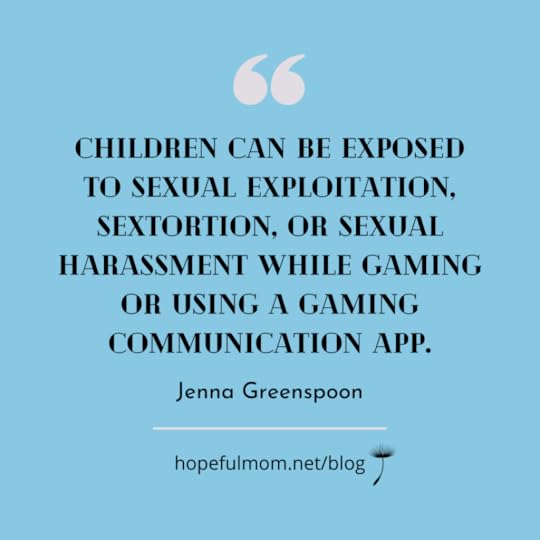
What Can You Do to Keep Your Child Safe?
There is no question that there are many risks when it comes to children and teens online. It’s a whole other world that parents need to worry about their children in. These tips will help you keep your child safe and protected online.
It may sound simple enough, but talk to your child. Many parents have a hard time talking to their children about online safety, especially when it comes to sexual content. However, it is extremely important that children understand the repercussions of sharing images or videos of themselves online, especially with people they do not know. Share stories from the news with your children so they understand these situations happen and that it is extremely important to remain aware of the dangers and how to be safe online. Remind your child not to accept or open images or download links with unknown content from people they do not know. While opening a link or downloading a file can be dangerous for their computer and privacy, it is also possible they may open explicit images or videos. Tell them to never go into a chat or change apps to connect with someone they met privately online. In many cases, this is where sextortion or sexual exploitation takes place. Once a child is lured by an online predator into a private chat or app, the predator uses it as an opportunity to sexually harass and blackmail that child. Use a protective software on your child’s computer to keep your child safe while remaining in the know about your child’s gaming behavior. Try a software like ProtectMe which alerts parents of any dangers their child comes in contact with while gaming. ProtectMe sends a report with threats detected as well as recommendations on how to deal with the threat with your child. Use the ProtectMe report to identify which games your child is playing and ensure they are age appropriate. Report any harassment or inappropriate sexual content. Block any player that makes your child feel uncomfortable in any way. Keep a record of the inappropriate content to use for the report.
Keeping your child safe while gaming online is a big job. Jenna Greenspoon of Kidas is at Hopeful Mom with Tips to Keep Your Teens Safe From Online Sexual Exploitation and Harassment #onlinesafety #onlinegaming
Click To Tweet
Keeping your child safe online is a big job. Keeping them safe from sexual content or sexual exploitation online can feel scary and overwhelming. With open communication, support from websites like this one and software like ProtectMe, you can keep your child protected from dangers online.
We at Hopeful Mom appreciate your support and readership. We love helping others learn how to educate and communicate with their children, so please share this post with your friends. Subscribe below to receive updates from Hopeful Mom, as well as information on Barb’s upcoming book. And be sure to connect on Facebook, Instagram, and LinkedIn.
The post Tips to Keep Your Teens Safe From Online Sexual Exploitation and Harassment appeared first on HOPEFUL MOM.
January 9, 2023
3 Reasons Children Fear Talking to Parents About Porn
In October I spoke at the SHE Recovery Virtual Summit, an online conference for females who have struggled with pornography. During the summit, I ran a poll asking attendees this question:
Girls, what’s the biggest fear that keeps you (or kept you) from telling your parents about your pornography problem?
Most of the answers fell into three categories: shame, disappointment, and judgment.
Parents, grandparents, and leaders need to understand why children fear disclosing their behavior. When we comprehend the emotional anguish feeding into their silence, we can guide them better.
Shame
“Sex in general was shameful and not something you could talk about.” – one respondent
People stuck in the cycle of watching pornography, committing to stop, and then slipping back into the behavior (because porn is alluring and addictive), experience shame, a negative emotion caused by guilt.[i] They understand their behavior is wrong, and when they are unable to willfully stop, their shame intensifies.
Sometimes, when parents learn their children are participating in unhealthy behaviors, they unintentionally shame their children. Their words, attitudes, and actions reveal they are either ashamed of themselves or their children. And the shame the child already feels is reinforced. If our children anticipate this type of reaction, they will stay quiet, continuing to bear the weight of their problem alone.
3 Reasons Children Fear Talking to Parents About Porn – Barb of Hopeful Mom asked girls: What's the biggest fear keeping you from talking with your parents about porn? The answers fell into three categories. #hopefulmom…
Click To Tweet
Disappointment
“I thought they would think I’m a terrible person and wouldn’t know what to do with me.” – one respondent
Let’s face it, parents can be disappointed in their children. It’s a reasonable emotion. We have expectations and our child falls short. We’re disappointed and fear that they’re stuck in this negative behavior.
Wanting to satisfy parents’ hopes and expectations is natural, even noble. But the problem arises when children shield parents from disappointment by deceiving them into believing all is well.
Judgment
“I witnessed them discussing pornography and using words like disgusting, vile, scum.” – one respondent
Wow. This particular response hit me hard. Of course children are reluctant to confess to behaviors their parents have referred to with such negative terms and attitudes.
We don’t need to scroll on social media longer than a few minutes to realize we are, in general, a people of opinions and judgments. And I am no exception. I believed people who viewed pornography on a regular basis were unintelligent and shady characters. However, I changed my perspective. Anyone can be swept up in the porn industry’s grasp.
Changing the Atmosphere
“It’s just weird to talk to your parents about that.” – one respondent
The girls who responded to the poll were afraid their parents would be disappointed in them or judge them for their behaviors. Their fear of disappointing their parents or being judged by them stopped them from speaking up. Another fear was shame. They either felt too much shame to divulge their behavior or had witnessed their parents shame others for watching pornography. Therefore, the respondents assumed their parents would have the same attitude toward them and their behaviors if they confessed.
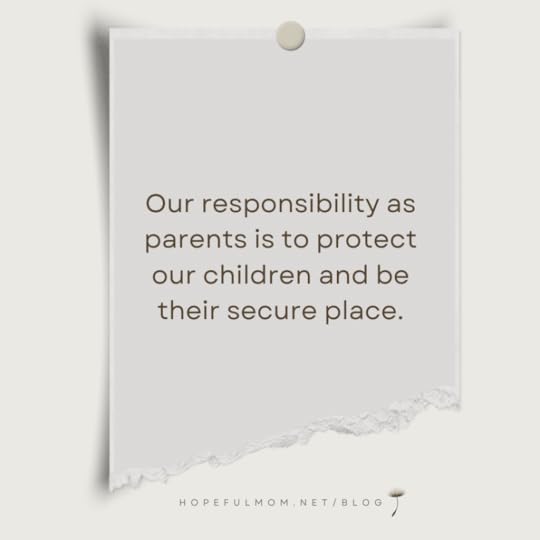
Our job is to change the atmosphere within our homes. Here are some suggestions.
Watch tone, words, and attitude. Every person is special and unique. Make an effort to show love and compassion for each individual, regardless of their circumstances or way of life.Focus on behavior, not the person. Say, “Watching pornography is an unhealthy choice,” rather than, “A person who watches pornography is a monster.”Allow children to fail. Humans err and choose unwisely at times. Rather than stand over them in a judgmental fashion, stoop next to them and offer to help them get back up.Talk about the awkward subjects. When we broach the tough topics, our children will know that no subject matter is too difficult to talk about.Be vulnerable. Tell stories of poor choices you’ve made in the past and the outcomes, positive and negative.Be available. Interact with your child daily. Look them in the eye, ask open-ended questions, and express interest in their life. When we press pause on the busyness and listen to our children, they are more apt to trust us when their life takes a turn for the worse.Pretending harmful things don’t exist won’t keep our children safe. I know it’s awkward to discuss sex, sexuality, online grooming, pornography, and everything in between, but it’s our responsibility to protect our children and be their secure place. Let’s bring what’s lurking in the darkness to the light. You can do it!
Thanks for walking this journey with me. Please subscribe below for updates on posts, my upcoming book, and a FREE PDF download. Follow Hopeful Mom on Facebook and Instagram, and share this post on social media. In doing so, you may help another parent realize they are not alone.
[i] https://www.merriam-webster.com/dicti...
The post 3 Reasons Children Fear Talking to Parents About Porn appeared first on HOPEFUL MOM.
December 26, 2022
Sexting: Helping Our Children Heal From This Epidemic
Kristen Miele of Sex Ed Reclaimed is with us to talk about sexting. I met Kristen when she and I were each presenting at the SHE Recovery Summit. Her topic was sexting, and I quickly asked her to share her expertise at Hopeful Mom. I’m so grateful she agreed.
Sending nudes. Sharing pics. Snapu puas (sending nudes, the words upside down and backwards!). Texxxting. ‘You up?.’
Slang and teenagers go together like pumpkins and pie. There are many terms for sexting: sending explicit photos over the phone, in messages, and online. As adults, we’ll never understand all of the current slang. We actually don’t need to. However, what we do need to know is how to help our children prevent and heal from the epidemic of sexting.
A report in JAMA Pediatrics states over 25% of teenagers are receiving sexts, while 15% of teenagers are sending them. About 11% of teens are forwarding pictures they’ve received, without any consent from the sender. These text messages can end up as material for someone to ‘sextort’ the sender. Sextortion is a play on words combining sexting and extortion. The predators can be anyone. Predators typically have a goal of acquiring more and more explicit sexual content from the sender or child. Netsmartz, an online safety education program fighting the popularity of sexting, shares that, sadly, 4% of children engage in self-harm or attempt suicide as a result of sextortion.
No child wants to be manipulated or taken advantage of. Kids are being objectified, both by other kids and adults.
How can we help our children fight the widespread popularity of sexting?
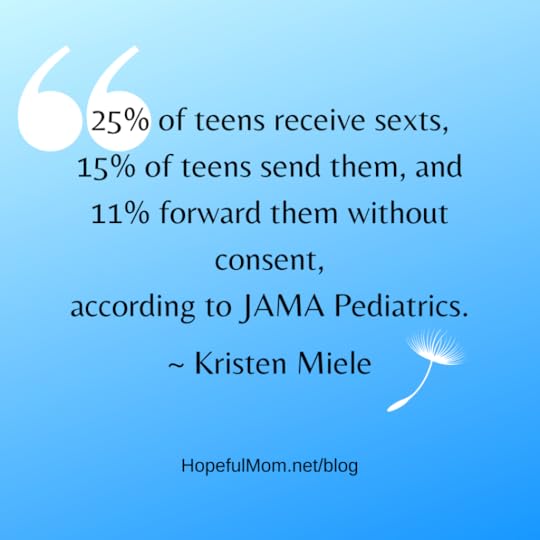 Education
EducationI’ve been a sexual health educator for over 10 years. I’ve seen the sad reality of the effects of sharing naked images. This is especially heartbreaking because zero children will benefit from sending nude photos or receiving them.
Education can be the first step in preventing the next generation from continuing this unhealthy cycle. Honest, willing, age-appropriate conversations are important when it comes to talking about sex. Do you shy away from talking to your child? Have you begun talking to your kids about porn?
With children under nine, use the phrase ‘bad images,’ when they see a picture with someone naked.Frame your conversations with kids to be educational.Discussions should be informative, truthful, and practical.What can kids do when another child passes over a phone or switches to a show where nudity is involved? Encourage them to ask the other child what they’re about to see and talk to an adult when they’ve seen something that makes them uncomfortable. Please notice I wrote the word ‘when’ in the prior sentence. Pornography is almost always seen by the time a child enters 6th or 7th grade.
Thankfully, parents have great options like filters on phones, shared parent-child social media accounts, options besides smart phones, and consistent conversations with their youth. Instead of allowing fear to rule in parenting when it comes to sex, join the offensive team, and move to defense only when you must. Engage in talks with your child about media you consume, news you overhear together, conversations which come up, and question that arise.
25% of teens receive sexts (nudes). Discussions about this topic with our children should be informative, truthful, and practical, says Kristen Miele of Sex Ed Reclaimed. Sexting: Helping Our Children Heal From This Epidemic #consent
Click To Tweet
If your child has been exposed to porn (which includes sexting), tell them you’re sorry, because that is not a healthy, holy, or appropriate place for them to learn about sex. Offer to talk about it and consider counseling as well as new boundaries in the home or in relationships. Point to the good Creator who lovingly directs us that sex is best in a covenant relationship with a spouse. Anyone asking your son or daughter for pictures is not respecting them, loving them well, or treating sex with a right attitude. Sex is not cheap, nor is it ‘not a big deal,’ and their bodies are not for sale. Porn, however, teaches the opposite.
Model within your family how to cope with difficult feelings. Maybe you journal, pray, exercise, listen to music, write, or converse when things are hard. Help your child do the same. Kids turn to sexting and porn when they’re lonely, stressed, overwhelmed, bored, lack control in the home, or go through big life stressors. Help them to name their feelings, identify the truth in the feeling (if there is any), and move to healthy coping mechanisms in daily life.
ConsiderEmphasize to your children that people asking for seductive pictures or nudes are untrustworthy, even if your child knows them, is dating them, or believes this will impress them or create intimacy. Can your child block that person or report them to an authority if applicable? Consequences children face post-sexting include ramifications in schooling or scholarships, as well as revenge porn and leaked images (once they send it, it’s out of their control).*
If you think your teen would disclose, you could start a conversation by asking if they’ve ever shared images, or received them. We never want to shame our kids, but we want to be honest about potential consequences. Sadly, whole websites have been devoted (and some shut down) to revenge porn, a direct effect of sextortion and sexting.
God has a beautiful design for sex and it’s so much greater than other people using us for our bodies. His design matters. He created our bodies and sex. Shouldn’t we look to Him to see what His purpose for them is? Does your child know what their Creator says? Jesus loves us, sees us, knows us, forgives us, and moves towards us, even in our great pain, shame, or suffering. He can do this in the life of your child.
Please share this post on social media, and remember to subscribe below for a FREE PDF download. Keep up with Hopeful Mom on FB and IG .
*Note from Barb: Anyone (including a minor) caught possessing or distributing explicit photos of minors can be legally charged.
The post Sexting: Helping Our Children Heal From This Epidemic appeared first on HOPEFUL MOM.
December 12, 2022
What You Need to Know About Consent
In the show Ghosts, a modern-day character, Samantha, sees and hears ghosts who reside in the mansion she owns. Each lived during a different time period in history and died in the mansion. In one episode, Hetty, who lived in the 1880’s, has the opportunity to converse with the maid her husband had an affair with while she was living. Hetty has been holding a grudge since before her death. She confronts the maid, accusing her of chasing after her husband.
Wide-eyed, Molly responds, “He pursued me. I wasn’t interested. I didn’t know what to say. So I didn’t say anything.”
Modern-day Samantha chimes in. “Power of dynamics. Hetty’s husband was in a position of power over Molly, which he knew. And I’m sure you needed that job.”
Molly replies, “Yes. I had a child to feed, and my husband had perished at the mill.”
Hetty says, “I didn’t know that.”
Molly says, “I guess I can’t blame you for hating me. He was your husband . . .”
Hetty responds, “That’s just the way things were.”
Thankfully, times have changed.
I recently spoke on the topic of consent with a group of male college athletes. The teaching starts with a few purposefully vague scenarios. My colleagues and I aren’t trying to mislead the students; rather, we’re making the point that consent, specifically for sex, is a tricky topic.
The college students were attentive and polite, but many did not completely understand the law. That isn’t surprising. Consent is a relatively new term for some of us, and we are still trying to figure it out.
Definition“Consent is an agreement between participants to engage in sexual activity. Consent should be clearly and freely communicated. A verbal and affirmative expression of consent can help both you and your partner to understand and respect each other’s boundaries.
Consent cannot be given by individuals who are underage, intoxicated or incapacitated by drugs or alcohol, or asleep or unconscious. If someone agrees to an activity under pressure of intimidation or threat, that isn’t considered consent because it was not given freely. Unequal power dynamics, such as engaging in sexual activity with an employee or student, also mean that consent cannot be freely given.”[i]
Notice that an underage person cannot agree to sex. In Florida, you need to be 18. If an 18-year-old has sex with a 16-year-old, even if s/he says it’s okay, the parents of the 16-year-old can accuse the 18-year-old of sexual battery. And I’ve seen it happen.
Also notice an unequal power dynamic means consent cannot be freely given. (Refer to the Ghosts example.) Whether or not someone commits sexual battery can depend on their position of authority or their age relative to the victim’s age.
While some laws appear harsh, they were enacted to protect the innocent, those who feel intimated, coerced, or pushed into participating in sexual activity.
Consent laws may appear harsh, but they were enacted to protect the innocent, those who feel intimidated, coerced, or pushed into participating in sexual activity. What You Need to Know About Consent #hopefulmom #consent
Click To Tweet
On the day I spoke with those college guys, I told them, “No means no. That’s a given. However, the lack of a response may also mean no.” Some people tend to freeze when they’re in an uncomfortable position, especially when one person appears to have power over the other (i.e. older, stronger, an employer, etc.). A “yes” is not ongoing and can be withdrawn at any time. Consent needs given at each step leading up to and including intercourse.
In other words, we’re looking for an enthusiastic yes. “Enthusiastic consent is a newer model for understanding consent that focuses on a positive expression of consent. Simply put, enthusiastic consent means looking for the presence of a ‘yes’ rather than the absence of a ‘no.’ Enthusiastic consent can be expressed verbally or through nonverbal cues, such as positive body language like smiling, maintaining eye contact, and nodding. These cues alone do not necessarily represent consent, but they are additional details that may reflect consent. It is necessary, however, to still seek verbal confirmation. The important part of consent, enthusiastic or otherwise, is checking in with your partner regularly to make sure that they are still on the same page.”[ii]
Bottom line: communication is important. If a person is not mature enough and bold enough to ask specific questions, discern nonverbal clues, and wait for a definitive answer—an enthusiastic yes—they aren’t mature enough to participate in sexual activity.
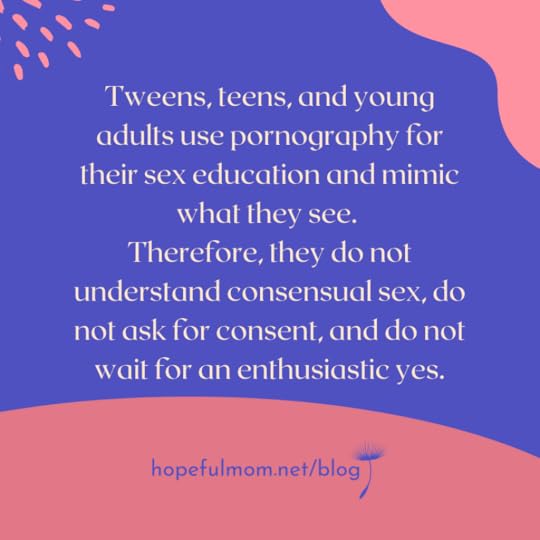 Consent and Pornography
Consent and PornographyUnfortunately, pornography portrays men mistreating women. The “plot” depicts a woman saying no but eventually enjoying the act. The women aren’t agreeing, and the men ignore their pleas to stop. But in the end, everyone is happy.
We know this is unrealistic. Our children do not. They use pornography for their sex education and mimic what they see. Therefore, they do not understand consensual sex, do not ask for consent, and do not wait for an enthusiastic yes.
But we can change the conversation. We can talk with our children about consent and how pornography depicts unrealistic expectations.
When is the last time you spoke with your preteen or teen about consent? Do they know the legal definition as well as the principle behind the law?
COMING AUGUST 2023: Sexpectations: Helping the Next Generation Navigate Healthy Relationships. This book includes information about consent. Subscribe for updates to be the first to know when the book is available. BONUS for subscribing: immediate access to a FREE download: 7 Steps After Your Child Sees Porn. Also keep up with Hopeful Mom on social media at our FB page and IG page.
[i] https://www.rainn.org/articles/what-is-consent
[ii] Ibid.
The post What You Need to Know About Consent appeared first on HOPEFUL MOM.



